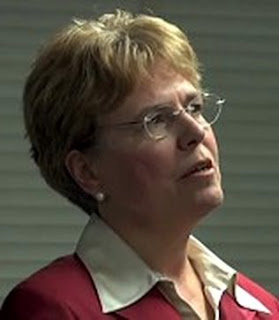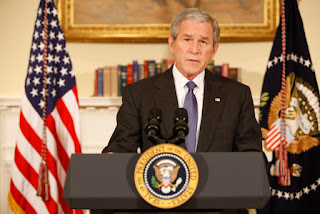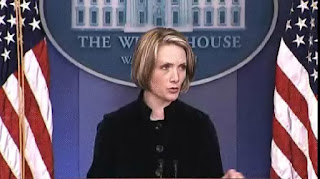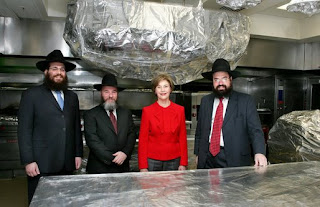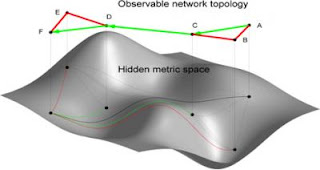MS. PERINO: Hey, everybody. A couple of things for you. The President just met with Rich Williamson -- he's the special envoy -- the President's special envoy to Sudan -- to receive an update from him on the situation in Darfur and the status of a comprehensive peace agreement that the North and South are trying to work out.
Also this morning, at 10:20 a.m., the President will drop by Mrs. Bush's meeting in the Yellow Oval Room in honor of the U.S.-Afghan Women's Council. The President and President Karzai launched this council to support Afghan women in the areas of political and economic participation, literacy, education, legal awareness, and then access to health care. Mrs. Bush is welcoming new members and will announce that Georgetown University will manage the council with the transition to a new administration.
Earlier this morning, Mrs. Bush participated in a secure video teleconference with Afghan women entrepreneurs in the Roosevelt Room, and afterwards, Mrs. Bush will also participate in interviews with David Jackson of USA Today and Greta Van Susteren of Fox News.
This morning, at 10:45 a.m., the President will make remarks on presidential perspectives on domestic policy-making to employees and guests of the American Enterprise Institute at the Renaissance Mayflower Hotel, just across the street here in Washington. He will also answer questions that have been collected from audience members. So you'll have that in just a minute.
The President this afternoon will participate in an interview with Steve Scully of C-SPAN; that's at 1:15 p.m.
And then I would point you to, just to highlight, yesterday the Department of Justice's Bureau of Justice Statistics announced that 2007 violent crime and property rates were at or near the lowest level since 1973. That was the first year that data was collected, in 1973. And more information can be found at the DOJ website, for Bureau of Justice Statistics.
And with that, I'll take a drink, and then take your questions.
Go ahead, Jennifer.
Q We've heard from the podium and then also from the President himself over the weekend on Air Force One that a decision about the automakers would come very quickly. And now we're into Thursday; the week is starting to wind down. Should we assume that this means that there may not be a way to find bailout money for the automakers?
MS. PERINO: No. I would just remind you, it was just a week ago that the legislation on Capitol Hill did not pass. And so what we were left with then was to try to come up with how do we move forward.
Just to step back for a minute, if you thought that our economy today could handle the collapse of the American auto industry, then you might come to the conclusion that doing nothing was an option. In a strong economy, we would probably come to that conclusion, as well. But we don't have a strong economy today. We're in the middle of a recession, and we have continued credit and financial market issues that we're trying to work through. And the overwhelming evidence is that the collapse of the American auto industry would have a terrible negative consequence for our national economy, resulting in massive job losses, the failure of many businesses who are dependent on the auto industry. The ripple effect would be quite strong.
And so once you've decided that the economy cannot withstand that type of a blow, then the only question is how do you deal with it. And I know that there are a lot of opinions out there about how to deal with it, or to not deal with it at all. But there's only one person who has the responsibility to make a decision and to get the answer right once Congress failed to act, and that's the President. And that's why it's just taking us a few days to get information from the companies, digest it, see how we could provide possible short-term help to them.
I will tell you this: The President is not going to allow a disorderly collapse of the companies. That is not an option. Some people have assumed that that's one of things that we would decide. That is not going to be the case. When the President says we're going to take all of this into account he means that we're going to do something. And we're nearing a conclusion, we're narrowing options. I just don't have anything for you today.
Q Let me just ask two things quickly. Do you think the week will end without a decision? And, two -- this may have been asked before, so forgive me if it's a repeat -- but when you say "disorderly collapse," can you explain what that means? Does that mean that there's some kind of collapse that's okay, but a certain other kind of one is not?
MS. PERINO: By that I mean a disorderly collapse would be something very chaotic that is a shock to the system. There's an orderly way to do bankruptcies that provides for more of a soft landing -- I think that's what we would be talking about. That would be one of the options. I'm not saying that that is necessarily what would be announced.
And you asked if it would be before the end of the week. I just -- I can't tell you right now, but I can tell you we're nearing a conclusion and we're very close.
Q A structured bankruptcy, as opposed to a disorderly collapse, would involve the cooperation of the unions, the companies, various other stakeholders, presumably including some of the equity holders, and might take longer to arrange. Is that why this is taking so long?
MS. PERINO: That is one of the considerations that we're taking into account. If you remember, the legislation that we supported going back the past several weeks was one in that we said that all the stakeholders, all the ones that you listed, were going to have to come to the table and be willing to make some really tough decisions and concessions on their part in order to become viable companies in the future and to qualify for any taxpayer assistance, if there was going to be any.
That was -- what we thought was reasonable and appropriate was to provide the auto industry an acceleration on the money that was already appropriated for the auto industry. But because Congress didn't act, then the President is left with, okay, well, even though majorities in both houses of Congress said that they supported this action, now we have to look back and say, how can we do it.
And that doesn't -- but that doesn't mean that those stakeholders aren't going to have to make tough decisions. No matter what in this -- in any scenario that comes forward after this decision-making process, all those stakeholders are going to have to make tough decisions.
Q Can you give us any indication of how far along the process is?
MS. PERINO: I can say we're very close, but other than that I don't want to characterize it.
Q So -- but a sort of managed bankruptcy is a possibility?
MS. PERINO: I'd say it's in the spectrum of options, and there are a lot of options.
Go ahead.
Q And Chrysler Corporation, with its workers being essentially shut out at 21 plants for a month -- reaction to that and the impact of that -- of those closures?
MS. PERINO: Well, we certainly took that into account. There's no doubt that we're -- they're in a very fragile state right now. They usually do shut production for some bit of time at this time --
Q But not for a month.
MS. PERINO: -- but not for a month. So we are taking that into consideration. And again, the President has the responsibility to look at the economy in the big -- from the big picture. And if the economy was as strong as it was just a couple of years ago, or a year ago right before the credit collapse -- or the credit crunch -- then we wouldn't necessarily be having this conversation. But because the economy is in such a weakened state, he feels that he needs to do something. And that's why he's tasked his advisors to work round the clock to try to come up with something that would protect the taxpayers, but not allow a collapse that would hurt everybody in America.
John.
Q Sort of following on Bill's question, is it reasonable to think that you're trying to set up a process where those tough decisions are going to be made, as opposed to reaching the tough decisions this week?
MS. PERINO: You know, as frustrating as it is for you to not get answers from me -- I mean, it's as frustrating for me. I can't provide you anything more. But as soon as we can, I will. And then we'll be able to talk to you about the process we went through.
Helen.
Q What are the President's options, and how does he feel about the senators who represent states producing foreign cars over American?
MS. PERINO: Well, they all have their opinions. And as I said, there's a lot of people with opinions, but there's only one person that has the responsibility to make a decision that would be best for all Americans, and that's what he's trying to do.
There's a range of things that we could do, from providing -- one of the things we've said is that the President could provide some short-term financing through the TARP money; this is the rescue money that we had passed I think just the first week of October. That's one option.
Q He can do that by executive order?
MS. PERINO: It's one option that they're looking at to see if that would be possible. The other one would be one of these bankruptcy -- I mean, there's a range of options. I don't want to rule anything in or out, but there's a whole list of them.
Richard, did you have one?
Q Yes. I was just going to ask if it would be preferable to have fewer than three auto companies in this plan? Is that -- if you were --
MS. PERINO: I would just say that we want a robust auto industry in America, and we think that they can be competitive and viable, but they're going to have to make tough decisions to get there.
Mark.
Q Dana, did the White House reply to these seven Republican senators who urged the President not to use TARP funds for the auto industry?
MS. PERINO: I don't know if we have, in terms of a formal letter of response. But we've got letters from all sorts of members of Congress and people from across the country, expressing their desires and opinions on this matter. And we always respond in due course.
Q In due course? After you announce the --
MS. PERINO: Not necessarily. I mean, I think that there's a lot of conversations that are ongoing between us and Capitol Hill. We don't -- we never close off communication. But we were left with a situation that the President had to do something when Congress failed to act last week.
Q And using TARP money is still an option?
MS. PERINO: Yes. Yes, ma'am.
Q My name is Nazira Karimi, correspondent for Ariana Television from Afghanistan. This is the first time that I've been here.
MS. PERINO: Welcome.
Q Thank you. Women in Afghanistan -- I am a woman, I know the situation, women feeling out of the (inaudible) but still they are worried about the Taliban. And they say, why the Taliban get more power and we are (inaudible) power. So what is going to be the next policy of the United States?
MS. PERINO: Well, you'll get to hear from the President soon. He's having the event today. The President was just in Afghanistan this weekend, and I had the pleasure of being able to be there.
There's remarkable changes that have taken place since 2001. The fact that you're here today I think is a testament to that. And we have all of NATO agreeing to be a part of a effort to try to beat back the Taliban. I think that one of the things that we need to remind people of is that Afghanistan is the fourth poorest country in the world. They have a 78 percent illiteracy rate. When we go to try to train their troops, it's not like you can hold a class. You have to go out in the field and do a lot of repetition. And they're good soldiers and good fighters, but they just need a slightly different type of training than you could maybe do in someplace else like Iraq.
So there's a lot to be done, but we've come a long way, especially when it comes for little girls being able to go to school. And the President and Mrs. Bush have both said in recent days that they plan to remain involved in Afghanistan. And Mrs. Bush in particular has a soft spot in her heart for the women of Afghanistan, and she'll continue to work on their behalf.
Ann.
Q The Prime Minister's office in Iraq says that the Iraqi journalist has apologized for what he called an ugly incident. Has that been communicated to President Bush, and does he think there -- that an apology was necessary?
MS. PERINO: I've seen the reports of it. I've not seen the President today as to whether or not he's actually been apprised of those reports, as well. But as I said, the President harbors no hard feelings about it, and the Iraqis have a process that they'll follow. But he did urge them not to overreact, because he was not bothered by the incident, although it's not appropriate for people to throw shoes at a press conference, at any leader.
Q Can I ask another one, as well? Can you explain what regulations the President is changing to protect health care providers who do not choose to participate in abortion practices?
MS. PERINO: I'm not as well versed in this, in terms of the details. The Department of Health and Human Services could provide you more. But over the past three decades, Congress has enacted several laws in order to protect people who have a -- who want to practice their health care according to their conscience when it comes to reproductive rights. And this new regulation will increase awareness of those laws and compliance with them, but it doesn't change any of the laws in regards to reproductive rights. So it's just about people.
Q It supports what's already been passed by Congress?
MS. PERINO: Yes, and we think it clarifies it, because there have been laws passed over the past three decades and we think this puts it all in one place so that people can have all of their rights respected. But the Department of Health and Human Services could provide you more detail.
Mark.
Q Sorry, let me come back to the automakers for a second. You said that you were waiting -- you'd gotten information back from the companies, you're digesting it. You didn't mention the unions. I ask because the unions, in an attempt to get concessions ahead of agreement, was kind of where Congress found it. Are you guys talking to unions, too?
MS. PERINO: I'm not aware of all the details, but I know that they've been talking to the head of the UAW, sure.
Q Dana, a follow-up on that, if I may.
MS. PERINO: Go ahead.
Q Do you have any information if the journalist has been beaten or tortured in Iraqi custody?
MS. PERINO: No, I don't.
Q And another one if -- I'm sorry.
MS. PERINO: Go ahead.
Q There's been a report this morning from North Koreans; they claim they've thwarted a terrorist attempt on their leader, whatever. Do you have any information, any --
MS. PERINO: This is the first I've heard of it.
April.
Q Dana, back to Ann's question and another question. You were hurt in that shoe-throwing melee and he sent an apology. Do you accept his apology? You were the victim.
MS. PERINO: I don't think he apologized to me.
Q He didn't -- but you were --
MS. PERINO: What happened to me was just an accident in the melee. It's not -- I'm not bothered by it. It's not all that pretty, but I'm not worried about it. (Laughter.)
Q You didn't like those close-ups?
MS. PERINO: Goyal, go ahead.
Q Two questions --
Q No, no, I have one more question.
MS. PERINO: Oh, sorry. Go ahead.
Q Last night a U.S. magistrate judge imposed a severe sanction against the Secret Service for "willful noncompliance with discovery obligations" in the evidence hearing of a case over an alleged culture of pervasive racial discrimination within the Secret Service. And it's a decades-long case, Ray Moore versus the Secret Service/Chertoff. What are your thoughts about that?
MS. PERINO: April, I'm aware of the case. I wasn't aware of the judge's ruling, and I also think that -- my instinct is that if there's a judge's ruling that it's probably not appropriate for me to comment on it from the podium.
Q And the -- I guess what people are saying, in the era of Barack Obama, is there concern that this U.S. Secret Service agency is able, if there is indeed what is claimed a pervasive culture of racial discrimination within the agency, that President-Elect Barack Obama could indeed be protected as well as he is supposed to be?
MS. PERINO: I've never seen anything but the utmost professionalism by our United States Secret Service.
I'll take one more. Go ahead.
Q Can I get back to Bill's question about the auto bailout? Did I understand you correctly to say that an orderly bankruptcy is an option?
MS. PERINO: Yes. Okay, thank you.
END 10:32 A.M. EST For Immediate Release Office of the Press Secretary December 18, 2008








